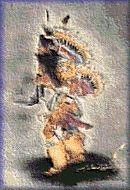This is the view of the pow wow celebrations as understood by myself. It is intended to give Non-Native Americans a fair insight into these celebrations. Any constructive comments are welcome as I appreciate that the descriptions given here may not be representative of all tribes.
These are probably the best introduction to indigenous culture. Pow-Wows are formal dances, (mostly competitive but with some element of ritual) and are held by tribes all over the USA throughout the year. There are two styles of Pow-Wow, Northern and Southern.
The differences are slight and for the most part, unnoticeable. Most last about three days and are sometimes combined with a rodeo. Although just about every reservation holds one or two Pow-wows every year, the most representative are probably those held by the Lakota (Sioux) in the Dakota States. These can attract members of up to 20 different tribes. The biggest Lakota Pow-wows are South Dakota's Rosebud fair and the Pine Ridge Pow-wow which are both held in August.
These reservations have some of the best known historical sites and battlefields which can be taken in at the same time. The Rosebud Sioux Fair and the Oglala Nation fairs attract dancers from all across the United States and Canada. Some families make a living travelling the Pow-wow circuit all summer long. The largest Pow-wow held in the United States and Canada is the Gathering of nations held in April in New Mexico.
This year they had some 2,500 dancers. There is a large, cleared field with tiered seating around a perimeter with trailers, tents and tipi.
On the first day, once all the dancers have gathered, the traditional drummers and singers begin to call on the Gods and ancestors.
The dancers - often more than a hundred of them - all enter the field to dance together for what is called the Grand Entry. This honours all the dancers and veterans. The Eagle Staff carried by a respected elder comes first, then veterans carrying the flags of their service, Pow-mia, State, Tribal and National flags.
Next comes the Head dancer. The Head staff consists of one male, one female, one boy and one girl dancer. The Head staff has an honoured position and must not only lead the dancers in intertribals, but perform a give - away for the honour of being Head staff. Next in line comes the Pow-wow Princes and Princesses of the other Pow-wows. There may also be a junior princess. Princesses are chosen for their looks and acheivements at school and cultural activities.
The dancers come next...Senior men's dancers, (Northern and Southern traditional), Men's Grass, and Men's Fancy dance, Senior Women's then Women's ( both Northern and Southern traditional), Women's Buckskin and Cloth, Jingle and Fancy shawl dancers.
The Junior, Children and tiny tots follow in the same order. After all the dancers are in the arena there is an invocation by a respected spiritual leader who asks for a good and safe dance and journey home. A Flag song is sung next, (Each tribe has it's own song honouring the American Flag), and then a victory song for all the veterans. During the victory song the colours are retired to the front of the announcement stand where they remain with the Eagle Staff until the end of the day.

The dance regalia varies from dancer to dancer. Most Northen traditional dancers wear a feather bustle made from Eagle and Hawk feathers and a hair roach that gives the look of a brightly coloured Mohawk. The roaches will have two Eagle tail feathers sticking up that move with the dancer. Most dancers will have bone breast plates and eagle wing fans.
All Traditional dancers have a dance stick which can be beaded, fur wrapped topped with an Eagle talon or even the head. Women's Northern traditional dancers have long tradional dresses made of heavy wool cloth or buckskin. They are beaded and can weigh over 80 lbs. The cloth outfits are usually covered with cowry shells or Elk teeth. (Real Elk teeth are valuable and a set of two can cost over $120).
The women dancers wear Eagle fluffs or a single Eagle feather at the back of the head. The dresses have long fringes that hang from the arms all the way to the ground. They also carry Eagle wing fans and a shawl draped over the left arm. Northern traditional dancers dance in place bending their knees in time with the drum.
Men Grass dancers wear outfits of long yarn or ribbon and dance with the wind imitating the movement of the long prairie grasses.
The Jingle Dress originated with the Eastern Woodland's Nations as a healing dance. The dresses are made of bright fabric and covered with snuff can lids rolled into cones. The Jingle dance is very energetic and the cones have an unmistakeable rattle to them.
Men's Fancy dancing originated in Oklahoma and the Wild West shows and is wild and athletic. The Fancy dance is all show and the outfits are created with the flashiest and brightest materials. The Women's Fancy shawl dance is their answer to the Men's Fancy dance and they wear a brightly coloured dress, but instead of the men's bustles (worn around the waist and neck) they have a colourful shawl and also wear knee high beaded leggings
It's best to camp out at night - then you can join in some of the camp-fire groups and listen to the storytellers and singers or just soak up the atmosphere.